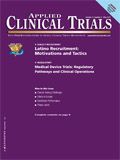A Financial Case for Loyalty Management
ISR Reports
It sounds fairly intuitive that if a service provider consistently meets customer expectations, then it will prosper financially. Industry Standard Research examined this relationship using four years of service provider performance data paired with share price for five leading CROs. The conclusion: There exists a very strong relationship between a CRO's service quality, as measured by ISR's Service Variability Index (SVI™), and its financial performance as measured by share price. Readers will recall that ISR created the SVI in 2009 as a representation of a service provider's consistency in meeting customer expectations.

On average service providers have improved their delivery consistency over the past four years.
ISR analyzed the SVI data from 2009, 2010, 2011, and 2012 alongside each company's closing stock price on the first day of trading in that year. This analysis includes 816 sponsor ratings of encounters with Covance, ICON, Kendle (to 2011), PAREXEL, and PPD. Both the SVI and the share price were indexed (100), using 2009 as the base year.
Two conclusions of note: Overall, these service providers have, on average, improved their delivery consistency over the past four years and with an R2 value of 70%, the SVI has a very strong relationship to the average company share price.
—Industry Standard Research, www.ISRreports.com.

Unifying Industry to Better Understand GCP Guidance
May 7th 2025In this episode of the Applied Clinical Trials Podcast, David Nickerson, head of clinical quality management at EMD Serono; and Arlene Lee, director of product management, data quality & risk management solutions at Medidata, discuss the newest ICH E6(R3) GCP guidelines as well as how TransCelerate and ACRO have partnered to help stakeholders better acclimate to these guidelines.
Gilead Shares Final Data from Phase III MYR301 Trial of Bulevirtide in Chronic Hepatitis Delta Virus
May 7th 2025Long-term results from the study show 90% of patients with chronic HDV who achieved undetectable HDV RNA at 96 weeks of treatment remained undetectable for nearly 2 years post-treatment.